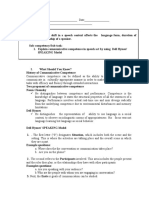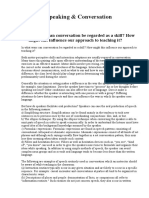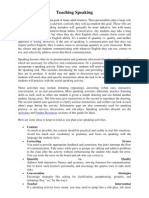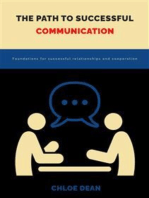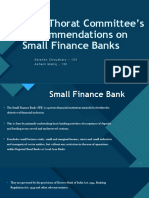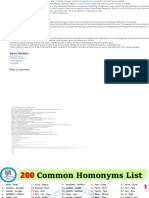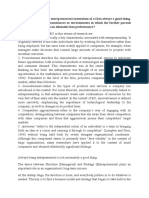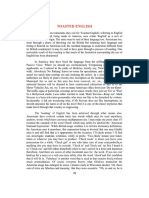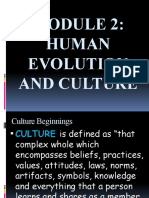Bkfytdyutxghuljh
Bkfytdyutxghuljh
Uploaded by
anjuCopyright:
Available Formats
Bkfytdyutxghuljh
Bkfytdyutxghuljh
Uploaded by
anjuOriginal Description:
Original Title
Copyright
Available Formats
Share this document
Did you find this document useful?
Is this content inappropriate?
Copyright:
Available Formats
Bkfytdyutxghuljh
Bkfytdyutxghuljh
Uploaded by
anjuCopyright:
Available Formats
Bkfytdyutxghuljh
Small talk and conversation are examples of interactional talk, which refers to
communication that primarily serves the purpose of social interaction Small talk consists of
short exchanges that usually begin with a greeting, move to back-and-forth exchanges on
non-controversial topics, such as the weekend, the weather, work, school, etc. and then
often conclude with a fixed expression, such as See you later. Such interactions are at
times almost formulaic and often do not result in a real conversation. They serve to create a
positive atmosphere and to create a comfort zone between people who might be total
strangers. Topics that are appropriate in small talk may differ across cultures, since topics
that are considered private in some cultures (e.g. marital status or religion) can be
considered as appropriate topics for small talk in other cultures. While seemingly a trivial
aspect of speaking, small talk plays a very important role in social interaction. Learners who
cannot manage small talk often find they come away from social encounters feeling
awkward, or that they did not make a good impression, and, consequently, may avoid
situations where small talk is required.
Skills involved in mastering small talk include:
Acquiring fixed expressions and routines used in small talk.
Using formal or casual speech depending on the situation.
Developing fluency in making small talk around predictable topics.
Using opening and closing strategies.
Using back-channelling. Back-channelling involves the use of expressions such
as really, mm, Is that right?, yeah, etc., nodding of the head, and, very commonly,
short rhetorical questions, such as Do you? Are you? or Did you? Such actions and
expressions reflect the role of an active, interested and supportive listener.
One of the most important aspects of conversation is managing the flow of conversation
around topics. Whereas topics are only lightly touched on in small talk, as we noted above,
conversation involves a joint interaction around topics and the introduction of new topics
that are linked through each speaker’s contributions. The skills involved include:
Initiating a topic in casual and formal conversation.
Selecting vocabulary appropriate to the topic.
Giving appropriate feedback responses.
Providing relevant evaluative comments through back-channelling.
Taking turns at appropriate points in the conversation.
Asking for clarification and repetition.
Using discourse strategies for repairing misunderstanding.
Using discourse strategies to open and close conversations.
Using appropriate intonation and stress patterns to express meaning Learners need
a wide range of topics at their disposal in order to manage the flow of conversation,
and managing interaction and developing topic fluency is a priority in speaking
classes. Initially, learners may depend on familiar topics to get by. However, they
also need practice in introducing new topics into conversation to move beyond this
stage.
Agenda management and turn-taking are also important features of small talk and
conversation. The former refers to the participant’s right to choose the topic and the way the
topics are developed, and to choose how long the conversation should continue. This
includes strategies for opening, developing and closing conversations, and for introducing
and changing topics. This process is often jointly managed by the participants, depending
on the social relationship between them (e.g. teacher– student, friend–friend, employed–
employee). Turn-taking involves providing opportunities for another person to take a turn in
speaking and recognizing when another speaker is seeking to take a turn.
Another important communication skill is the ability to use English to accomplish different
kinds of transactions. A transaction is an interaction that focuses on getting something
done, rather than maintaining social interaction. (In communicative language teaching,
transactions are generally referred to as functions, and include such areas as requests,
orders, offers, suggestions, etc.) A transaction may consist of a sequence of different
functions. Two different kinds of transactions are often distinguished. One type refers to
transactions that occur in situations where the focus is on giving and receiving information,
and where the participants focus primarily on what is said or achieved (e.g. asking someone
for directions or bargaining at a garage sale). The second type refers to transactions that
involve obtaining goods or services, such as checking into a hotel or ordering food in a
restaurant. Talk in these situations is often information- focused, is associated with specific
activities and often occurs in specific situations. The following are examples of
communication of this kind:
Ordering food in a restaurant.
Ordering a taxi.
Checking into a hotel.
Changing money at a bank.
Getting a haircut.
Buying something in a store.
Borrowing a book from the library.
Transactional activities can be thought of as consisting of a sequence of individual moves or
functions which, together, constitute a ‘script’. For example, when people order food in a
restaurant, they usually look at the menu, ask any necessary questions and then tell the
waitperson what they want. The waitperson may ask additional questions and then repeat
their order to check. When people check into a hotel, the transaction usually starts with a
greeting, the clerk enquires if the person has a reservation, the client confirms and provides
his or her name and so on.
In using language in this way, the goal is to carry out a task. Communicating information is
the central focus, and making oneself understood, unlike small talk or conversation, where
social interaction is often as important as what the participants actually say. In addition, the
language used in carrying out transactions is often predictable, contains many fixed
expressions and routines, and, as we noted in the earlier example, and may contain
elliptical or short forms instead of fully-formed sentences ,since transactions can often be
performed using key words and communication strategies, but not necessarily employing
grammatically appropriate language. Communication strategies are tactics learners use to
compensate for limitations in their linguistic skills and that enable them to clarify their
intentions, despite limitations in grammar, vocabulary or discourse skills.
The skills involved in using English for transactions thus include:
Selecting vocabulary related to particular transactions and functions.
Using fixed expressions and routines.
Expressing functions.
Using scripts for specific transactions and situations.
Asking and answering questions.
Clarifying meanings and intentions.
Confirming and repeating information.
Using communication strategies.
You might also like
- BTL-6000 High Intensity Laser: User'S ManualDocument32 pagesBTL-6000 High Intensity Laser: User'S Manual3lf100% (1)
- Use of English: Grammar: 1 Complete The Text With The Correct Passive Form of The Verb in BracketsDocument6 pagesUse of English: Grammar: 1 Complete The Text With The Correct Passive Form of The Verb in Bracketsana maria csalinas75% (4)
- Dosage Calculation Practice WorkbookDocument35 pagesDosage Calculation Practice Workbookcrazy crazy crazy100% (1)
- Speaking ProcessDocument3 pagesSpeaking ProcessAmir Aziz100% (6)
- BkfytdyutxghuljhDocument2 pagesBkfytdyutxghuljhanjuNo ratings yet
- Transactional and Interactional Language (Short Bond Paper)Document4 pagesTransactional and Interactional Language (Short Bond Paper)AngelaOrosiaDenila75% (4)
- Transactional and Interpersonal in ConversationsDocument2 pagesTransactional and Interpersonal in ConversationsFadli RafiNo ratings yet
- q2 Modules 1 4 EditedDocument10 pagesq2 Modules 1 4 EditedEdison MontemayorNo ratings yet
- Developing Classroom Speaking Activities From TheoDocument11 pagesDeveloping Classroom Speaking Activities From TheoRafaelMacielNo ratings yet
- MonologueDocument13 pagesMonologueЮля СалашникNo ratings yet
- Teaching Speaking: Towards A Holistic Approach: November 2016Document13 pagesTeaching Speaking: Towards A Holistic Approach: November 2016OvistasNo ratings yet
- Module 8 - Oral Communication in ContextDocument9 pagesModule 8 - Oral Communication in ContextDayne Gracee RamosNo ratings yet
- Types of Communicative Strategy: Lesson 1Document25 pagesTypes of Communicative Strategy: Lesson 1Joniel Niño Hora BlawisNo ratings yet
- Group 8 APLDocument13 pagesGroup 8 APLnithkh1200No ratings yet
- ELT Methodology: Teaching SpeakingDocument34 pagesELT Methodology: Teaching Speakingkavya.noriNo ratings yet
- Communication StrategiesDocument3 pagesCommunication StrategiesSadiriNo ratings yet
- Article Presentation by Carinne Karlick ESL 501Document19 pagesArticle Presentation by Carinne Karlick ESL 501raju19785186No ratings yet
- Listening SkillsDocument8 pagesListening SkillsNet Green IINo ratings yet
- Linguistic and Non-Linguistic FactorsDocument3 pagesLinguistic and Non-Linguistic FactorsThakur Anjeev PrakashNo ratings yet
- Topic 5Document9 pagesTopic 5Arian MarsinyachNo ratings yet
- ETA RocpaperDocument13 pagesETA Rocpaperjunelot56No ratings yet
- Blue and Beige Modern Abstract Seminar Proposal PresentationDocument26 pagesBlue and Beige Modern Abstract Seminar Proposal PresentationKendrix Adaptar TinongaNo ratings yet
- Topic Digest by Garque LeanDocument8 pagesTopic Digest by Garque LeanLean GarqueNo ratings yet
- Strategies in Various Speech Situations: Intrapersonal CommunicationDocument5 pagesStrategies in Various Speech Situations: Intrapersonal Communicationkenneth minozaNo ratings yet
- 04 Verbal Communication SkillsDocument21 pages04 Verbal Communication SkillsMuhammad AkhtarNo ratings yet
- Learning Ouput #7Document3 pagesLearning Ouput #7MAUREEN JANE MACTALNo ratings yet
- Oral Communication 2nd QRT Mod.9Document7 pagesOral Communication 2nd QRT Mod.9Shai Felix De Leon100% (2)
- Chapter 11Document3 pagesChapter 11VLADIMIR SOLANO GONZÁLESNo ratings yet
- Communicative StrategyDocument14 pagesCommunicative StrategyMelissa R.Bartolay100% (2)
- Speech Style ActivityDocument1 pageSpeech Style ActivityImmaculate FallariaNo ratings yet
- Assignment. ComnicationDocument7 pagesAssignment. ComnicationBenjamin L KhiangteNo ratings yet
- Week6 SpeakingDocument36 pagesWeek6 SpeakingelaltmskrNo ratings yet
- Method of Speaking - 2Document70 pagesMethod of Speaking - 2hasdar73No ratings yet
- Understanding Speech ContextDocument15 pagesUnderstanding Speech ContextjosephinepradoborjaNo ratings yet
- Q2 01 - Communicative Strategies PDFDocument55 pagesQ2 01 - Communicative Strategies PDFRoanne Matel DepEdNo ratings yet
- Business CommunicationDocument12 pagesBusiness CommunicationPushpa BaruaNo ratings yet
- SOCIO FixxsDocument14 pagesSOCIO Fixxshanifatul husniNo ratings yet
- Types of Communicative StrategyDocument23 pagesTypes of Communicative StrategyMay Ann Pineda83% (6)
- Teaching Speaking & ConversationDocument3 pagesTeaching Speaking & ConversationPsic. Ó. Bernardo Duarte B.No ratings yet
- English MFDocument13 pagesEnglish MF.No ratings yet
- Communication StrategiesDocument9 pagesCommunication Strategiesambionred109319No ratings yet
- 2nd Quarter Lesson 2Document6 pages2nd Quarter Lesson 2Charleston RoaNo ratings yet
- Verbal & Nonverbal-TranscriptDocument10 pagesVerbal & Nonverbal-TranscriptAngelica Marie DiegoNo ratings yet
- LECTURE-NOTES-LESSON-10-11-COMMUNICATIVE-STRATEGIES-AND-SPEECH-ACTSDocument2 pagesLECTURE-NOTES-LESSON-10-11-COMMUNICATIVE-STRATEGIES-AND-SPEECH-ACTSRoxanne Mae PuraNo ratings yet
- MODULE 9-10 SummaryDocument6 pagesMODULE 9-10 SummaryJess Reille Espinas-BaykingNo ratings yet
- Oral Comm Module 3Document5 pagesOral Comm Module 3Marcco Juan MarccoNo ratings yet
- Utilize Specialized Communication SkillsDocument26 pagesUtilize Specialized Communication SkillsBeede AshebirNo ratings yet
- Chapter 14 - L201B - Working in EnglishDocument19 pagesChapter 14 - L201B - Working in EnglishghazidaveNo ratings yet
- HTTPDocument3 pagesHTTPMido MesbachNo ratings yet
- Contexts of Communication RevisedDocument15 pagesContexts of Communication RevisedShiloh FrederickNo ratings yet
- Principles of SpeakingDocument2 pagesPrinciples of SpeakingKarla Rebecca CamposNo ratings yet
- Module 8Document4 pagesModule 8Darlene Dale LapingNo ratings yet
- Communicative StrategiesDocument4 pagesCommunicative Strategieshezekiah minNo ratings yet
- Teaching SpeakingDocument3 pagesTeaching SpeakingGoogo Ramerame Huh0% (1)
- SLM Oral Communication MELC 9Document22 pagesSLM Oral Communication MELC 9Kawit Engineering100% (1)
- Communicative Competence Strategies in Various Speech SituationsDocument4 pagesCommunicative Competence Strategies in Various Speech SituationsJoniel Niño Hora BlawisNo ratings yet
- J.R.Firth's, Dell Hymes', M.A.K Halliday's Model of ContextDocument7 pagesJ.R.Firth's, Dell Hymes', M.A.K Halliday's Model of ContextNguyễn Hóa100% (1)
- Adjacency PairsDocument5 pagesAdjacency PairsKayla Camille A. MiguelNo ratings yet
- Verbal Non Verbal For MBA - 1037500568799378547Document12 pagesVerbal Non Verbal For MBA - 1037500568799378547PRAGYA SHARMA100% (1)
- The Power of Small Talk: Unlocking the Secrets of Casual ConversationFrom EverandThe Power of Small Talk: Unlocking the Secrets of Casual ConversationNo ratings yet
- The Art of Communication How to Communicate Effectively: Self help, #4From EverandThe Art of Communication How to Communicate Effectively: Self help, #4No ratings yet
- The path to successful communication: Foundations for successful relationships and cooperationFrom EverandThe path to successful communication: Foundations for successful relationships and cooperationNo ratings yet
- Usha Thorat Committee's Recommendations On Small Finance BanksDocument12 pagesUsha Thorat Committee's Recommendations On Small Finance BanksanjuNo ratings yet
- Dana Hinders: Post A CommentDocument3 pagesDana Hinders: Post A CommentanjuNo ratings yet
- Is Increasing The Entrepreneurial Orientation of A Firm Always A Good Thing. or Are There Circumstances or Environments in Which The Further Pursuit of Opportunities Can Diminish Firm Performance?Document9 pagesIs Increasing The Entrepreneurial Orientation of A Firm Always A Good Thing. or Are There Circumstances or Environments in Which The Further Pursuit of Opportunities Can Diminish Firm Performance?anjuNo ratings yet
- Toasted English: R K NarayanDocument11 pagesToasted English: R K Narayananju100% (1)
- Acf PresenntationDocument6 pagesAcf PresenntationanjuNo ratings yet
- Toasted EnglishDocument6 pagesToasted Englishanju100% (1)
- Financial AnalysisDocument18 pagesFinancial AnalysisanjuNo ratings yet
- Synonyms AntonymsDocument15 pagesSynonyms Antonymsanju100% (1)
- English: B.A 2 Year 3 SemDocument25 pagesEnglish: B.A 2 Year 3 SemanjuNo ratings yet
- Mutual FundsDocument7 pagesMutual FundsanjuNo ratings yet
- Differentiation' Is Key For Axis Bank's India Wealth ManagementDocument3 pagesDifferentiation' Is Key For Axis Bank's India Wealth ManagementanjuNo ratings yet
- Synopsis FormatDocument4 pagesSynopsis FormatanjuNo ratings yet
- Measurement and Management of Translation Exposure: Agbs-HydDocument20 pagesMeasurement and Management of Translation Exposure: Agbs-HydanjuNo ratings yet
- Basic CalculationDocument14 pagesBasic CalculationanjuNo ratings yet
- Statement of Cash FlowsDocument11 pagesStatement of Cash FlowsanjuNo ratings yet
- Axis Bank Launches Burgundy Private'-Its Private Banking PlatformDocument2 pagesAxis Bank Launches Burgundy Private'-Its Private Banking PlatformanjuNo ratings yet
- Product Mix Strategy - Module IDocument57 pagesProduct Mix Strategy - Module IanjuNo ratings yet
- Top-10 Trends in Wealth Management: 2019: What You Need To KnowDocument27 pagesTop-10 Trends in Wealth Management: 2019: What You Need To KnowanjuNo ratings yet
- Dividend PolicyDocument25 pagesDividend PolicyanjuNo ratings yet
- Leadership: BBA 4 SemesterDocument30 pagesLeadership: BBA 4 SemesteranjuNo ratings yet
- All Schemes Half Yearly Portfolio - As On 31 March 2020Document1,458 pagesAll Schemes Half Yearly Portfolio - As On 31 March 2020anjuNo ratings yet
- RMRP Module 1 PDFDocument34 pagesRMRP Module 1 PDFanjuNo ratings yet
- Final Ratio Analysis (2) - 2Document4 pagesFinal Ratio Analysis (2) - 2anjuNo ratings yet
- Custom Tambola Housie Tickets PDFDocument5 pagesCustom Tambola Housie Tickets PDFanjuNo ratings yet
- Ratio AnalysisDocument39 pagesRatio AnalysisanjuNo ratings yet
- A Project Report On "The Study of Topic Name"Document86 pagesA Project Report On "The Study of Topic Name"anjuNo ratings yet
- FlopX NT5.1 Patch V1aDocument5 pagesFlopX NT5.1 Patch V1aAmilcar AndradeNo ratings yet
- Difference Between Qualitative and QuantitaveDocument13 pagesDifference Between Qualitative and QuantitaveFarooq SialNo ratings yet
- Ad1 - Britanico Gold - Reading Task - March 2021: Which Student MentionsDocument1 pageAd1 - Britanico Gold - Reading Task - March 2021: Which Student MentionsJamir Reaño SanchezNo ratings yet
- Reports On TECHNICAL ASSISTANCE PROVIDED by The Teachers To The Learners / Learning FacilitatorsDocument2 pagesReports On TECHNICAL ASSISTANCE PROVIDED by The Teachers To The Learners / Learning FacilitatorsJerv AlferezNo ratings yet
- Ecco Case AnalysisDocument2 pagesEcco Case AnalysisJean Christophe Gedeon100% (1)
- GLA45AMG 156 133 Rear Axle Oil ChangeDocument4 pagesGLA45AMG 156 133 Rear Axle Oil ChangeNhật Anh TrầnNo ratings yet
- A Therapists Guide To EMDR Tools and Techniques For Successful Treatment (Laurel Parnell (Parnell, Laurel) ) (Z-Library)Document372 pagesA Therapists Guide To EMDR Tools and Techniques For Successful Treatment (Laurel Parnell (Parnell, Laurel) ) (Z-Library)Gissel QuinteroNo ratings yet
- Orgonomic Diagnosis of Cancer BiopathyDocument16 pagesOrgonomic Diagnosis of Cancer Biopathyh1schmittNo ratings yet
- 3rd Summative Test in English - Q1Document4 pages3rd Summative Test in English - Q1Gessle GamirNo ratings yet
- UG 4th Semester Regular Programme 2024 Model SybDocument6 pagesUG 4th Semester Regular Programme 2024 Model Sybsnon7608No ratings yet
- 1310762395.starforge Kira XliDocument17 pages1310762395.starforge Kira XliDavid MooreNo ratings yet
- Alimentary Canal Class 10 - Google SearchDocument1 pageAlimentary Canal Class 10 - Google Search28g6pf8bhgNo ratings yet
- 467ECFIR361060 Statement of AccountDocument5 pages467ECFIR361060 Statement of AccountChb RamasasthryNo ratings yet
- Failure Mechanisms of Insulated Gate Bipolar Transistors (Igbts)Document30 pagesFailure Mechanisms of Insulated Gate Bipolar Transistors (Igbts)Wee Chuan PoonNo ratings yet
- Call For Papers On WomenDocument4 pagesCall For Papers On WomenShetty shubham rangaNo ratings yet
- Manual For Development ProjectsDocument126 pagesManual For Development Projectshayat_shaw100% (1)
- Spesifikasi CARL ZEISS Opmi Lumera T PDFDocument1 pageSpesifikasi CARL ZEISS Opmi Lumera T PDFJimmyNo ratings yet
- Syllabus Business CommunicationDocument3 pagesSyllabus Business CommunicationerenkrcNo ratings yet
- 1-Classification of Heat Exchangers & Selection CriteriaDocument56 pages1-Classification of Heat Exchangers & Selection CriteriaShahid_Rao786100% (1)
- Module 2 UCSPDocument35 pagesModule 2 UCSPRaiza CabreraNo ratings yet
- Becoming A LeaderDocument85 pagesBecoming A LeaderLokesh RajputNo ratings yet
- Cloud 101 - Basics of Using and Controlling Cloud-Based Applications Presentation 1Document55 pagesCloud 101 - Basics of Using and Controlling Cloud-Based Applications Presentation 1Swetha GhantaNo ratings yet
- 06 06 2024 Utv400 DPRDocument1 page06 06 2024 Utv400 DPRNato Joko PrayotoNo ratings yet
- Normative Ethics: Truth-Apt Imperatives Expressions of Emotion Expressions of "Pro-Attitudes"Document5 pagesNormative Ethics: Truth-Apt Imperatives Expressions of Emotion Expressions of "Pro-Attitudes"Vital TejaNo ratings yet
- Economics Grade 11 Lesson Note 2Document10 pagesEconomics Grade 11 Lesson Note 2Eyerusalem solomonNo ratings yet
- 13142833663.5.6 DCVG Equipment Rev 1Document2 pages13142833663.5.6 DCVG Equipment Rev 1ilublessingNo ratings yet
- Assessment 2 - Bernard Tschumi Transcripts - by Lim - Alexander - 3180281 - MediumDocument4 pagesAssessment 2 - Bernard Tschumi Transcripts - by Lim - Alexander - 3180281 - MediumpauloNo ratings yet


























